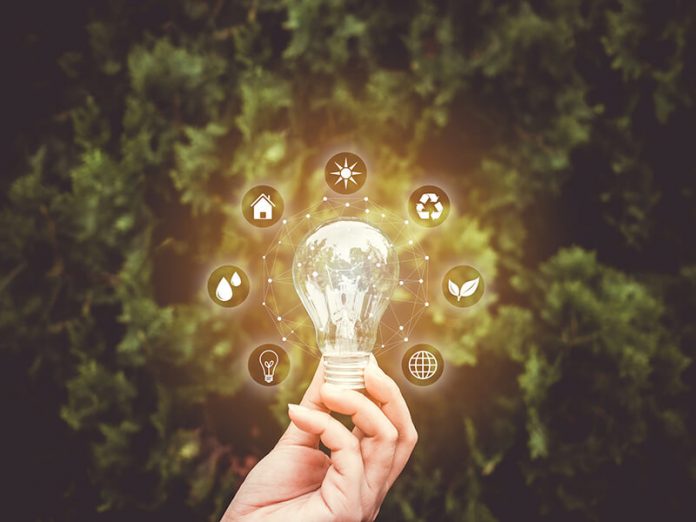By Jean-Marc Ollagnier, Sybille Berjoan, Dr Jacques Bughin and Yuhui Xiong
Companies’ efforts to become more sustainable can often be driven by regulation or government incentives. We propose a different approach – one that harnesses digital technologies to drive growth.
The first question CEOs should be asking about their sustainability efforts is not “Are we compliant?” but rather, “What value are we creating?”
Consider: Energy and sustainability policies around the world have long been a mix of regulation and stimulation. Compliance is critically important. And recent pandemic- related increases in funding1 offer an additional push for top executives to strive for increased sustainability. But do companies gain market share, revenue growth, or increased profits because they’ve taken actions in the interests of compliance, tax breaks, or subsidies? Not nearly to the extent they could. When compliance and/or incentives are the primary drivers for “green work”, it’s easy to miss opportunities to strengthen performance.
We think that executives should consider sustainability through a different lens. Specifically, we propose that they invest in sustainability as a means to expand, move into new markets, or even create new markets. Our recent research, which included a global, multi-dimensional study of more than 4050 companies (and incorporated random forest machine learning) bears out the potential of this approach. We studied four explicit time periods: 2016 – 2020; January 2020 – June 2020; July 2020 – December 2020; and 2021 (expected). For more detail, please see the full report2.The critical caveat – and the key to succeeding – is blending the adoption of advanced digital technologies with sustainable growth interests. In this way, technology becomes the tool that both enables and augments sustainability.
Many companies – regardless of regulatory requirements and incentives – see the value in becoming more sustainable businesses. At the same time, most companies are investing in digital technologies. It’s the linking of those two streams, an approach we call a “twin transformation”3, that makes the difference. Specifically, we found that companies that pursue sustainability as a digital growth path are more than 2.5 times likely to be among tomorrow’s leading organizations. (Our criteria for a leading organization rests on an ability to restore and sustain positive operating growth as COVID effects continue; detail can be found here.)4 Twin transformers, regardless of their industry, expect to be among those posting profitable growth by the end of 2021, even as the effects of the pandemic persist (and as some industries thrive and others struggle in its continuing wake).
Interestingly, twin transformers were not necessarily companies leading on digital adoption or on the sustainability front. In Europe, for example, just 22% of the companies that were leading in either digital or sustainability were also Twin Transformers. We found similar percentages in North America. In the Asia Pacific region, we found more: 34% of those leading in digital or sustainability were also Twin Transformers. (Our study focused on large companies; there are more twin transformers among smaller digital natives.)
What does it take to combine a company’s digital and sustainable transformations, with innovation and value creation the objective? Based on our survey, a series of follow-up interviews, and our own client experience, we have identified five crucial activities.
Five activities frame twin transformation
Twin transformers differentiate beginning with the way they set their direction and carrying through to the ways in which they engage with their workforce.
1. Setting direction
Twin transformers do not layer sustainability efforts or digital adoption onto existing busines models (though prior to starting their twin transformation journey, they may have done so). Instead, they integrate scenario thinking into their strategy development process with the explicit purpose of identifying high potential models that will serve combined growth and sustainability interests.
Twin Transformers also explore ecosystem plays as a matter of course, seeking opportunities for faster, further scaling of their busines models, as well as deeper sustainability impact. In this way, they conceive of ways to gain traction with new strategies as they shift gears and pull away from the old.
Following through, they learn through incubator programs that convene an ecosystem of partners. These pilots revise and test their business models for viability and impact. A majority of twin transformers in our study (61%) already generate more than 10% of their revenues through ecosystem plays, and nearly 80% expect to do so within three years.
Schneider Electric5 offers an example. This global company based in France, convened with the New Energy Opportunities (NEO) Network6 to explore growth models in just this way. The NEO network is a global community and online market platform of more than 300 corporate renewable energy purchasers and providers, supported by leading market analytics that serve to match supply with demand. Schneider teamed up with Walmart to use this network to support Walmart’s “Project Gigaton,”7 which aims to avoid a gigaton of CO2 emissions that would otherwise have been created through Walmart’s global value chain by 2030.
2. Combining resources
Twin transformers’ resource allocation explicitly reflects the understanding that sustainability and technology are not separate priorities. Instead, twin transformers direct innovation investment to initiatives that bring together sustainability impact and the power of technology. Some do so by earmarking a specific share of R&D investment to that combination. Others set up dedicated innovation entities whose mandate is to develop, test, and scale business ideas that deliver sustainability impact through technology. All twin transformers convene diverse innovation teams that bring together technology and sustainability expertise.
With such blended priorities, Christian Hansen8, a bio-engineering company, created SweetyR Y-1,the first patented probiotic culture that can reduce added sugar in yogurt; the invention won the World Innovation Award9 for best new dairy ingredient at the 2019 Global Dairy Congress in Lisbon. In 2020, 82% of the company’s revenues were associated with activities devoted to enabling sustainable agricultural practices, reducing food waste, and improving customer health. And, as part of its 2025 strategy (ending with the close of the 2024/2025 fiscal year), Christian Hansen will invest heavily in R&D to innovate natural and microbial nutrition solutions supported by digital technologies such as AI, machine learning, digital twins, and automation.
3. Combining financial and non-financial KPIs to create organization-wide ownership.
Twin transformers identify and assign key performance indicators (KPIs) that go beyond financial results; often, these are linked to executive compensation. As a result, managers have clear structural support for decisions that support blended digital and sustainability goals. These KPIs might include progress on emissions reduction, share of products with positive societal impact, or share of resources procured from sustainable sources.
To gain a big-picture view of impact beyond financials, twin transformers also measure progress on factors such as environmental impact, employee wellbeing, and consumer experience. Many have developed custom methodologies and tools to do so, complementing traditional ESG metrics with measurements of the business impact of sustainable practices.
Kering, the French luxury goods company, measures and quantifies its environmental impact through an environmental profit and loss10 (EP&L) account. The EP&L has helped the company shift to a sustainable business model by making environmental impacts visible, quantifiable, and comparable. Through a digital platform and tool, the company also provides public access to the open data behind the EP&L. Kering has also convened hackathons with developers, tech experts, and sustainability specialists to create apps and digital solutions aimed at reducing the impact of the fashion industry on the environment.

4. Aligning partners for sustainable product lifecycles and improved traceability
Twin transformers proactively monitor the other companies in their value chains, often screening them against sustainability factors. To raise their value chain’s overall sustainability, they also collaborate with suppliers, for example by offering training in sustainable practices. Additionally, many deploy blockchain technology and digital sourcing platforms in collaboration with partners to improve the resource and product traceability. Doing so builds the foundation for new, circular business models. These activities also build trust with consumers, by helping them increase their knowledge of what goes into the goods they buy.
L’Oréal, for instance, engages in a traceability program focused on palm oil (a common cosmetics ingredient), in partnership with its suppliers. All of the palm oil the company uses meets the high standards set by the Roundtable on Sustainable Palm Oil.11 L’Oréal has also designed a tool to evaluate sustainability progress, measuring improvements in its packaging, the footprint of its formulas, ingredient sourcing, and the social benefits of its products.
Similarly, Deutsche Post DHL Group developed a “GoGreen Carbon Dashboard”12 that clients can use to view analyses of carbon emissions associated with their shipments. The dashboard enables business customers to map emissions across their supply chains and develop viable reduction strategies.
5. Facing the skills challenge
Finally, twin transformers are more likely to take responsibility for building and nurturing talent than others. Sixty-one percent of twin transformers believe they are responsible for the continued employability of their people, compared with 44% of other companies.
Vodafone’s ReConnect initiative13, launched in 2016 in the UK, helps women who have been out of the workforce to rejoin it in a way that positions them for sustained success. Specifically, it provides training, coaching, flexible working options and an induction program focused on digital talent and skills for the future.
Twin transformers are focused on realizing a better future for their businesses and for the planet. This focus is positioning them to lead in the post-COVID world. The good news is that there’s no great secret to their current and anticipated successes. With commitment and the right processes, your company can also become a twin transformer.
This article is originally published on March 26, 2021.
About the Authors

Jean-Marc Ollagnier is the chief executive officer of Accenture in Europe, with management oversight of all industries and services in Europe. He is also a member of Accenture’s Global Management Committee.

Sybille Berjoan leads the Accenture Research European team and drives the European Thought Leadership agenda.
 Dr Jacques Bughin is a strategic advisor to multiple companies and boards; he is retired from a 28-year career as senior partner and director of the McKinsey Global Institute.
Dr Jacques Bughin is a strategic advisor to multiple companies and boards; he is retired from a 28-year career as senior partner and director of the McKinsey Global Institute.
 Yuhui Xiong, research manager of the Economic Modelling and Data Sciences team of Accenture Research, is responsible for driving and developing data-driven analysis for thought leadership projects.
Yuhui Xiong, research manager of the Economic Modelling and Data Sciences team of Accenture Research, is responsible for driving and developing data-driven analysis for thought leadership projects.
References
- https://www.euronews.com/2021/02/10/eu – multi – billion – pandemic – recovery – fund – gets – go – ahead – from – european – parliament
- https://www.accenture.com/us-en/insights/strategy/european-double-up
- https://www.accenture.com/us-en/insights/strategy/european-double-up
- https://www.accenture.com/us-en/insights/strategy/european-double-up
- https://www.se.com/ph/en/
- https://neonetworkexchange.com/landing_page/main
- https://corporate.walmart.com/newsroom/2020/09 / 10 / walmart – and – schneider – electric – announce-groundbreaking-collaboration-to-help-suppliers-access-renewable-energy
- https://www.chr-hansen.com/en
- https://www.chr-hansen.com / _ / media / files / chrhansen / home /sustainability/reporting-and-disclosure/2018-19/chr-hansen-sustainability – report – 2018 – 19 . pdf
- https://www.kering.com/en/sustainability/environmental-profit-loss/
- https://inside-our-products.loreal.com / ingredients / palm- oil #:~:text = Palm%20oil %20is%20a%20vegetable , their % 20 emollient % 20 or % 20 foaming % 20 properties.
- https://www.dhl.com/global-en/home/logistics-solutions/green-logistics.html
- https://www.vodafonereconnect.com/




































